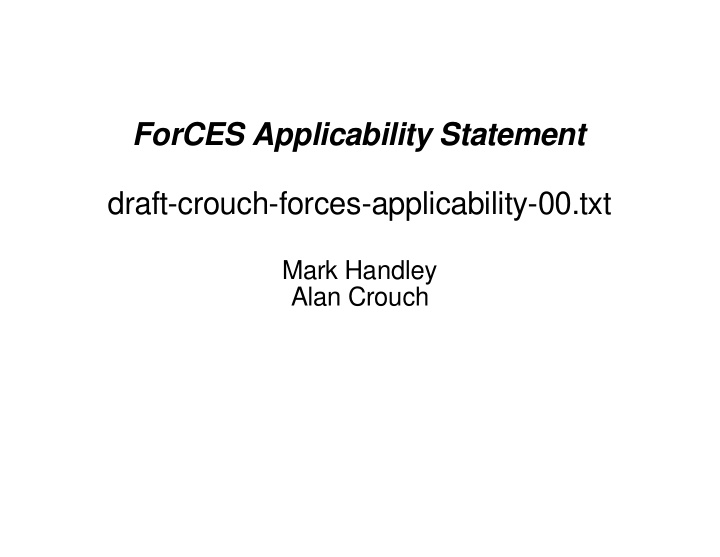



ForCES Applicability Statement draft-crouch-forces-applicability-00.txt Mark Handley Alan Crouch
ForCES Applicability Statement What is an Applicability Statement? A short draft stating what problems it’s reasonable to apply a protocol to. And perhaps which it isn’t. Why does ForCES need one? Management of expectations. To ensure we’re all on the same page so we can do something useful. To ensure that others (not here) are on the same page. To try to prevent people doing dumb things.
ForCES Applicability Statement What’s the process? First, the group agrees that it’s useful in principle. Hopefully today. Second, the group agrees with the content. Hopefully today. Then we resubmit it as a WG document. The document continues to evolve to track the WG’s consensus about how the ForCES protocol should be used. But we want to be careful not to try and micromanage usage - the document should remain short and high-level. Finally, around the time the ForCES protocol is standardized, the Applicability Statement should become an Informational RFC.
What’s in the Applicability Statement? Not much.
What’s in the Applicability Statement? Section Headings: 1. Overview 2. Terminology 3. Applicability to IP Networks 3.1. Applicable Services 3.2. CE-FE Link Capacity 3.3. CE/FE Locality 4. Limitations and Out-of-Scope Items 4.1. Out of Scope Services 4.2. Localities 5. Security Considerations
Applicable Services 3.1. Applicable Services Discovery: no, ForCES assumes it’s been done Capability Information Exchange: yes, both initial and dynamic. Topology Information Exchange: no, but may be used to convey results. Port Configuration: yes. e.g., set attributes such as IP addresses. Routing Exchange: yes. e.g., send routes to FEs, misses to CEs. ...
Applicable Services (cont) QoS Exchange: yes. FE may express capabilities. CE may configure the use of FE’s capabilities. Security Exchange: yes. e.g., setup of IPsec tunnel from FE. Filtering Exchange and Firewalls: yes. e.g. FE expresses capabilities, CE configures filters in FE. Encapsulation, Tunneling Exchange: yes. e.g. FE expresses capabilities, CE configures tunnels in FE. NAT and Application-level Gateways: yes for NAT. Not a design goal for app-level gateways, but may be applicable for some. Measurement and Accounting: yes, but note overlap with SNMP.
CE/FE Locality Summary: This section states what should be blindingly obvious. Use ForCES in: Very Close Localities Close Localities. Very Close Localities: Same box, rack, or similar. Basically we expect the CE-FE link to have high availability. Close Localities: Only a very small number of IP hops between CE and FE. Those IP hops shouldn’t be dynamically routed. Fate sharing.
CE/FE Locality: Close Localities Example scenario: FE is customer premises equipment. CE is at ISP facility. A single IP link separates CE and FE. FE is not uses to forward traffic between LANs at the customer premises. If CE-FE link fails, the FE wouldn’t have anything useful it could do anyway. Not in scope: As above, but CE-FE link is low bandwidth relative to control/monitoring traffic. Not in scope: As above, but FE also forwards traffic between LANs. If CE-FE link fails, internal forwarding at customer premises site fails.
Out of Scope Services Explicitly not addressed by ForCES: Label Switching Multimedia Gateway Control (MEGACO).
Summary This document basically states the obvious. But what’s obvious to us won’t necessarily be obvious to people not involved in the ForCES group. What next: Should this be a working group document? Is the current content an acceptable starting point?
Recommend
More recommend